sweetcostarica
BANNED
- Joined
- Jan 18, 2012
- Messages
- 619
April 15th, 2012
Note: I used whatever edge the knife came with to show the buyer that's what it's factory edge can do. The knives were not used at all before the field test.
Onion dicing
Because of their size none of the Kukris were very good in this test. Although it should be noted I am not skilled in the kitchen.
The best big knife in this test was the Tora Baldes Indra 32cm Kukri. There are several factors that caused this:
1. It was the shapest 2. It was the thinnest 3. It was the lightest (easier to control)
This knife cut the thinnest slices and had the smallest diced pieces.
The second best dicer was the Himalayan Imports 18" Sirupate. It's thicker spine hurt it's slicing ability and it wasn't as sharp as the other two big knives.
It did OK though.
The worst preformer of the three was the Ex-Gurkha Khukuri House Panawal Farmer Kukri. This 10" Kukri was very sharp but it's thickness hindered it's slicing and onion chopping preformace. It also was the shortest and heaviest kukri. The 28 ounce weight made it clumsy in the kitchen.
I learned a lot here. The most important thing was to bring a smaller knife in the field for this activity like a Mora, Fallkniven F1, Esee RC-4, etc. Big knives are too inept for food processing.
Field Testing
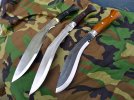
This test was done at Earthquake Park (Public) in Anchorage, Alaska
Feather Sticks
This test showed me how effective the starting curve area just after the Kaudi (cho) area is. On a Kukri this seems to be the best area to make feather sticks safely and competently.
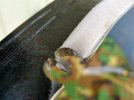
The Ex-Gurkha Khukuri House Kukri had the worse showing here. I think this is because as already noted it's thickness. The wide blade makes for a steeper angle that didn't allow fine shaving work.
When I started to use the Himalayan Imports 18" Sirupate I was shocked at the relative else of the blade throught the wood. It felt like butter in compaison to the Khukuri House blade. The design of this HI knife is perfect for making very thin pieces of wood. The winner in this test.
A very close second to the HI Sirupate was the Tora Indra 32cm Kukri. This knife did a wonderful job making feather sticks too. It was just as easy to make shavings but I felt a little less in cortrol of the blade. This could be because of it thinness, i.e. I had less to hold.
Splitting
The outstanding wood splitters were the Panawal Farmer and the Sirupate. Their thickness was an asset and really sent wood flying in two directions. When using a baton with the Tora Kukri to split wood I did feel vibration. But the vibration was manageable and it verified a solid handle. I took this as a positive. The Tora is an average splitter and clearly behind the other knives.
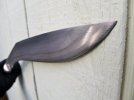
Chopping
Himalayan Imports 18" Sirupate didn't do as well as I thought it would. This sirupate cut the smallest pieces from wood and took longer to chop through the dead wood. Note: The blade was not as sharp as the other Kukris so you have to factor this in. The handle felt good in hand though and I had no vibration. This long knife's balance was good. You could almost cut paper with it before the test. After the test the blade was somewhat duller in the "sweet spot". When I returned home the HI knife was sharpened with the sandpaper/phonebook method to a nice slightly convexed sharp edge. This should make the sirupate a stronger chopper.
The Tora Indra 32cm Kukri was the deepest cutter and I was surprised in that it preformed so well being the lightest and thinnest of the three. It's balance was very good making controlled cuts easy. The heat treat seemed perfectly done on the Indra 32cm Kukri. This knife did not lose much if any of it's sharpness after all the onion tests and wood work. Light stropping was all that was needed to get the edge back to razor sharpness.
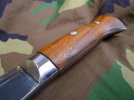
The knife that was the most comfortable to hold, had absolutely no vibration in the handle, and was the fastest through the wood is the 10" Ex-Gurkha Khukuri House Panawal Farmer Kukri. It's sharpeness, wideness, and shear weight made it a monster chopper. This knife was the best chopper but had the worst balance. The Panawal Farmer Kukri seemed more like an axe or hatchet. After the field test the blade stayed sharp in all but two (2) spots. The spots were about 3/4 to an inch long and were just slightly dulled. Re-sharpening the (possibly 5160) blade was effortless.
Price Paid
Himalayan Imports 18" Sirupate - 68 USD (bought as a "Blem" without sheath)
Ex-Gurkha Khukuri House Panawal Farmer Kukri - 90 USD
Tora Blades Indra 32cm Kukri - 120 USD
Note: All prices are totals. They include shipping and handling.
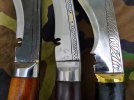
Concluding Opinion
All three companies had really good Kukris although the Ex-Gurkha Khukuri House's knife was clearly less refined. The tested/reviewed knives are users and that revolves around hiking and camping. So I almost always look for a lightweight efficent tool that is of high quality. As inferred above the fit and finish is superior on the Tora and HI. The 10" Ex-Gurkha Khukuri House Panawal Farmer Kukri would be excellent in a garage or as a truck knife but it's weight brings it down for anything else. Too heavy for me and not as all purpose a knife as the Himalayan Imports Sirupate. The Sirupate is a great allaround knife and I will be using it with a sharper/better edge when I hike. It is pleasant to hold and eventhough it's chopping ability was a little weak in comparison I think it's a very good Kukri.
Overall, I see the Tora Blades Indra 32cm Kukri as the best performer of the day. It's lighter weight and hard, sharp blade make it a perfect Kukri for the field. The Tora is well made and on a side note had the best Khukuri sheath I have ever owned.
I hope you enjoyed watching and reading about the strenghts and weaknesses of these different designs. I'll end here with a Brian Tracy quote:
"Happiness comes when you believe in what you are doing, know what you are doing, and love what you are doing".
Note: I used whatever edge the knife came with to show the buyer that's what it's factory edge can do. The knives were not used at all before the field test.
Onion dicing
Because of their size none of the Kukris were very good in this test. Although it should be noted I am not skilled in the kitchen.
The best big knife in this test was the Tora Baldes Indra 32cm Kukri. There are several factors that caused this:
1. It was the shapest 2. It was the thinnest 3. It was the lightest (easier to control)
This knife cut the thinnest slices and had the smallest diced pieces.
The second best dicer was the Himalayan Imports 18" Sirupate. It's thicker spine hurt it's slicing ability and it wasn't as sharp as the other two big knives.
It did OK though.
The worst preformer of the three was the Ex-Gurkha Khukuri House Panawal Farmer Kukri. This 10" Kukri was very sharp but it's thickness hindered it's slicing and onion chopping preformace. It also was the shortest and heaviest kukri. The 28 ounce weight made it clumsy in the kitchen.
I learned a lot here. The most important thing was to bring a smaller knife in the field for this activity like a Mora, Fallkniven F1, Esee RC-4, etc. Big knives are too inept for food processing.
Field Testing

This test was done at Earthquake Park (Public) in Anchorage, Alaska
Feather Sticks
This test showed me how effective the starting curve area just after the Kaudi (cho) area is. On a Kukri this seems to be the best area to make feather sticks safely and competently.

The Ex-Gurkha Khukuri House Kukri had the worse showing here. I think this is because as already noted it's thickness. The wide blade makes for a steeper angle that didn't allow fine shaving work.
When I started to use the Himalayan Imports 18" Sirupate I was shocked at the relative else of the blade throught the wood. It felt like butter in compaison to the Khukuri House blade. The design of this HI knife is perfect for making very thin pieces of wood. The winner in this test.
A very close second to the HI Sirupate was the Tora Indra 32cm Kukri. This knife did a wonderful job making feather sticks too. It was just as easy to make shavings but I felt a little less in cortrol of the blade. This could be because of it thinness, i.e. I had less to hold.
Splitting
The outstanding wood splitters were the Panawal Farmer and the Sirupate. Their thickness was an asset and really sent wood flying in two directions. When using a baton with the Tora Kukri to split wood I did feel vibration. But the vibration was manageable and it verified a solid handle. I took this as a positive. The Tora is an average splitter and clearly behind the other knives.

Chopping
Himalayan Imports 18" Sirupate didn't do as well as I thought it would. This sirupate cut the smallest pieces from wood and took longer to chop through the dead wood. Note: The blade was not as sharp as the other Kukris so you have to factor this in. The handle felt good in hand though and I had no vibration. This long knife's balance was good. You could almost cut paper with it before the test. After the test the blade was somewhat duller in the "sweet spot". When I returned home the HI knife was sharpened with the sandpaper/phonebook method to a nice slightly convexed sharp edge. This should make the sirupate a stronger chopper.
The Tora Indra 32cm Kukri was the deepest cutter and I was surprised in that it preformed so well being the lightest and thinnest of the three. It's balance was very good making controlled cuts easy. The heat treat seemed perfectly done on the Indra 32cm Kukri. This knife did not lose much if any of it's sharpness after all the onion tests and wood work. Light stropping was all that was needed to get the edge back to razor sharpness.

The knife that was the most comfortable to hold, had absolutely no vibration in the handle, and was the fastest through the wood is the 10" Ex-Gurkha Khukuri House Panawal Farmer Kukri. It's sharpeness, wideness, and shear weight made it a monster chopper. This knife was the best chopper but had the worst balance. The Panawal Farmer Kukri seemed more like an axe or hatchet. After the field test the blade stayed sharp in all but two (2) spots. The spots were about 3/4 to an inch long and were just slightly dulled. Re-sharpening the (possibly 5160) blade was effortless.
Price Paid
Himalayan Imports 18" Sirupate - 68 USD (bought as a "Blem" without sheath)
Ex-Gurkha Khukuri House Panawal Farmer Kukri - 90 USD
Tora Blades Indra 32cm Kukri - 120 USD
Note: All prices are totals. They include shipping and handling.

Concluding Opinion
All three companies had really good Kukris although the Ex-Gurkha Khukuri House's knife was clearly less refined. The tested/reviewed knives are users and that revolves around hiking and camping. So I almost always look for a lightweight efficent tool that is of high quality. As inferred above the fit and finish is superior on the Tora and HI. The 10" Ex-Gurkha Khukuri House Panawal Farmer Kukri would be excellent in a garage or as a truck knife but it's weight brings it down for anything else. Too heavy for me and not as all purpose a knife as the Himalayan Imports Sirupate. The Sirupate is a great allaround knife and I will be using it with a sharper/better edge when I hike. It is pleasant to hold and eventhough it's chopping ability was a little weak in comparison I think it's a very good Kukri.
Overall, I see the Tora Blades Indra 32cm Kukri as the best performer of the day. It's lighter weight and hard, sharp blade make it a perfect Kukri for the field. The Tora is well made and on a side note had the best Khukuri sheath I have ever owned.
I hope you enjoyed watching and reading about the strenghts and weaknesses of these different designs. I'll end here with a Brian Tracy quote:
"Happiness comes when you believe in what you are doing, know what you are doing, and love what you are doing".
